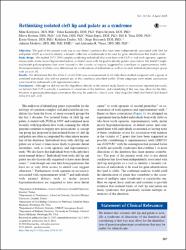| dc.contributor.author | Koruyucu, Mine | |
| dc.contributor.author | Kasımoğlu, Yelda | |
| dc.contributor.author | Seymen, Figen | |
| dc.contributor.author | Bayram, Merve | |
| dc.contributor.author | Patır Münevveroğlu, Aslı | |
| dc.contributor.author | Ergöz, Nihan | |
| dc.contributor.author | Tuna, Elif Bahar | |
| dc.contributor.author | Gencay, Koray | |
| dc.contributor.author | Deeley, Kathleen | |
| dc.contributor.author | Bussaneli, Diego | |
| dc.contributor.author | Modesto, Adriana | |
| dc.contributor.author | Vieira, Alexandre R. | |
| dc.date.accessioned | 10.07.201910:49:13 | |
| dc.date.accessioned | 2019-07-10T19:50:42Z | |
| dc.date.available | 10.07.201910:49:13 | |
| dc.date.available | 2019-07-10T19:50:42Z | |
| dc.date.issued | 2018 | en_US |
| dc.identifier.citation | Koruyucu, M., Kasımoğlu, Y., Seymen, F., Bayram, M., Patır Münevveroğlu, A., Ergöz, N. ... Vieira, A. (2018). Rethinking isolated cleft lip and palate as a syndrome. Oral Surgery Oral Medicine Oral Pathology Oral Radiology, 125(4), 307-312. https://dx.doi.org/10.1016/j.oooo.2018.01.007 | en_US |
| dc.identifier.issn | 2212-4403 | |
| dc.identifier.issn | 1528-395X | |
| dc.identifier.uri | https://dx.doi.org/10.1016/j.oooo.2018.01.007 | |
| dc.identifier.uri | https://hdl.handle.net/20.500.12511/2054 | |
| dc.description | WOS: 000429971300011 | en_US |
| dc.description | PubMed ID: 29500156 | en_US |
| dc.description.abstract | Objective. The goal of the present work was to use dental conditions that have been independently associated with cleft lip and palate (CL/P) as a tool to identify a broader collection of individuals to be used for gene identification that lead to clefts. Study design. We studied 1573 DNA samples combining individuals that were born with CL/P or had tooth agenesis, supernumerary teeth, molar incisor hypomineralization, or dental caries with the goal to identify genetic associations. We tested 2 single-nucleotide polymorphisms that were located in the vicinity of regions suggested to contribute to supernumerary teeth. Overrepresentation of alleles were determined for combinations of individuals as well as for each individual phenotypic group with an alpha of.05. Results. We determined that the allele C of rs622260 was overrepresented in all individuals studied compared with a group of unrelated individuals who did not present any of the conditions described earlier. When subgroups were tested, associations were found for individuals with hypomineralization. Conclusions. Although we did not test this hypothesis directly in the present study, based on associations reported previously, we believe that CL/P is actually a syndrome of alterations of the dentition, and considering it that way may allow for the identification of genotype-phenotype correlations that may be useful for clinical care. | en_US |
| dc.language.iso | eng | en_US |
| dc.publisher | Elsevier Science Inc | en_US |
| dc.rights | info:eu-repo/semantics/openAccess | en_US |
| dc.subject | Cleft Lip | en_US |
| dc.subject | Cleft Palate | en_US |
| dc.subject | Dental Anomalies | en_US |
| dc.subject | HMCN1 Protein Human | en_US |
| dc.subject | IGSF9 Protein Humanim | en_US |
| dc.subject | Munoglobulin | en_US |
| dc.subject | Nerve Protein | en_US |
| dc.title | Rethinking isolated cleft lip and palate as a syndrome | en_US |
| dc.type | article | en_US |
| dc.relation.ispartof | Oral Surgery Oral Medicine Oral Pathology Oral Radiology | en_US |
| dc.department | İstanbul Medipol Üniversitesi, Diş Hekimliği Fakültesi, Çocuk Diş Hekimliği Ana Bilim Dalı | en_US |
| dc.authorid | 0000-0002-8440-367X | en_US |
| dc.authorid | 0000-0002-5767-1791 | en_US |
| dc.identifier.volume | 125 | en_US |
| dc.identifier.issue | 4 | en_US |
| dc.identifier.startpage | 307 | en_US |
| dc.identifier.endpage | 312 | en_US |
| dc.relation.publicationcategory | Makale - Uluslararası Hakemli Dergi - Kurum Öğretim Elemanı | en_US |
| dc.identifier.doi | 10.1016/j.oooo.2018.01.007 | en_US |
| dc.identifier.wosquality | Q2 | en_US |
| dc.identifier.scopusquality | Q1 | en_US |


















